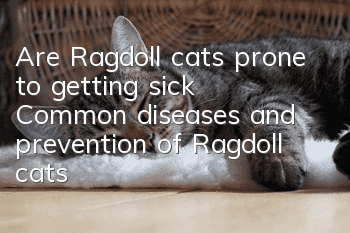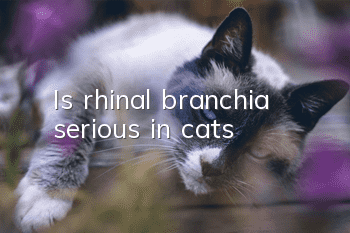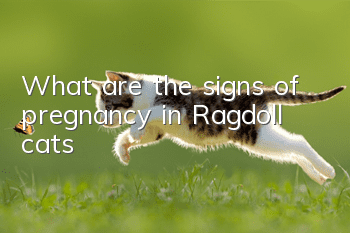Are Ragdoll cats prone to getting sick? Common diseases and prevention of Ragdoll cats!

The most important thing about raising cats is to ensure their health. Only when their health is guaranteed, can their happy life be further guaranteed. Therefore, when raising pet cats, every mother must first make all-round preparations for their health defense. Below, Boqi.com will teach you how to prevent and treat some common diseases of Ragdoll cats.
1. Cat dermatomycosis
Pet dermatomycosis is also called superficial mycosis. Dermatophytes are extremely resistant to external factors, especially dryness. It can survive for several months when exposed to sunlight or below 0°C. Fungi attached to dander on kennel equipment, posts, etc. can still maintain their infectivity even after 5 years. The spread of dermatophytes is mainly through contact between animals or through contaminated objects. When the number of pets is large and dense, it can also be spread through the air. External parasites such as lice, fleas, flies, mites, etc. are also important in transmission.
The symptoms of dermatomycosis are mainly round bald spots with broken hair on the skin of the pet’s head, neck and limbs, covered with gray scales. In severe cases, many ringworm spots are connected together. The course of the disease is longer. In mild cases, the symptoms are not obvious, and skin scales must be taken and microscopic examination can be done to confirm the diagnosis.
For home prevention and control measures, we must first keep the pet's skin clean and hygienic, and frequently check the coat for ringworm spots and scales; strengthen the management of cats and dogs at home to avoid contact with sick pets. If a pet at home is found to be infected with dermatomycosis, it must be isolated and treated in time. Griseofulvin 25-50 mg/kg body weight can be taken orally in 2-3 times for 3-5 weeks, which has a good effect on this disease. While using systemic therapy, the affected area should be trimmed and nystatin or polyaldehyde nystatin sodium ointment should be applied. The disease usually recovers within 2 to 4 weeks. Owners who have no breeding experience should send their pets to the veterinarian for early treatment. In addition, during treatment, special attention should be paid to the disinfection of cats, kennels, utensils, and home environments. Disinfectants can be 2 to 3% sodium hydroxide solution, 5 to 10% bleaching powder solution, 1% peracetic acid, 0.5% chlorhexidine solution, etc.
2. Feline urinary system diseases
Cat urinary system diseases are a common disease in cats, and are more common in male adult cats and old cats. The main symptoms are: the cat has frequent urination, difficulty in urinating and hematuria. If the owner finds that the cat stays in the litter tray for a long time, the smell of the litter tray changes, or the cat refuses to eat or becomes bloated, the cat may be suffering from urinary system diseases.
The cause of this disease: For cats, it may be related to the cat’s diet, such as too many minerals, too many auxiliary vitamins, etc. In addition, it may also be related to the daily life environment. For example, the cat lives in a noisy and poor environment, and the cat toilet is placed in an inappropriate or dirty location, causing the cat to hold in feces and urine, leading to bladder inflammation and even urinary stones.When a cat develops a urinary system disease, it should be sent to a veterinary clinic for examination in time. Severe disease may cause the cat to vomit and become comatose during the day to prevent complications.
To prevent cats from developing urinary system diseases, the most important thing is to keep the environment and the cat toilet clean and sanitary, and place the cat toilet in a secluded and safe place so that the cat can go to the toilet with confidence. At the same time, for cats that eat dry food every day, be sure to prepare enough clean water to prevent the cat from being excessively thirsty and drinking dirty water indiscriminately.
3. Feline panleukopenia
Feline panleukopenia, also known as feline infectious enteritis or feline distemper, is caused by cats An acute, highly contagious, and fatal infectious disease of cats caused by parvovirus. It mainly occurs in kittens under 1 year old. The clinical manifestations are sudden high fever, vomiting, diarrhea, high degree of dehydration and obvious decrease in white blood cell count. It is the most common infectious disease in domestic cats.
This disease mainly affects cats, but other animals of the feline family (wild cats, tigers, leopards) can be infected. Kittens have special susceptibility. Sick animals are the main source of infection of this disease. The virus is excreted in vomit, saliva, feces and urine, contaminating food, tableware, catteries and the surrounding environment, causing susceptible cats to become infected after contact. The main portal of entry is Digestive tract and respiratory tract. A few weeks or more than a year after recovery, sick cats can still excrete toxins from their feces and urine to the outside world. During the acute period, fleas and some blood-sucking insects can also spread the disease. After the pregnant cat is infected, it can also be transmitted vertically to the fetus through the entrapment. This disease is more common in late autumn to winter and spring. The incidence rate from December to March of the following year accounts for more than 55.8%, of which the incidence rate in March reaches 19.5%, and the duration of the disease is usually 3-6 days. If you can survive for 7 days, you will most likely recover. The case fatality rate is generally 60-70%, and can reach more than 90%.
1. Symptoms
The incubation period of this disease is generally 2-6 days. In susceptible cats, the infection rate is as high as 100%, but not all infected cats develop symptoms. According to the clinical manifestations, it can be divided into the following 3 clinical types:
(1) The most acute type: the sick cat dies suddenly before symptoms appear, and is often misdiagnosed as a poisoning disease.
(2) Acute type: The sick cat only shows prodromal symptoms such as listlessness and loss of appetite, and soon dies within 24 hours.
(3) Subacute type: At the beginning of the disease, the sick cat is lethargic and has a loss of appetite. The body temperature reaches above 40°C. After 24 hours, it drops to normal temperature. After 2-3 days, the body temperature rises to 40°C again. Above C, there is obvious biphasic heat. During the second fever, the symptoms intensified. The sick cat was highly depressed, weak, and lay down with its head resting on its forelimbs. Vomiting and diarrhea occur. Passage of blood, watery stools, and rapid dehydration. When sick cats have high temperatures, the number of white blood cells can be reduced to less than 2,000 cells/mm (normal cats are 15,000-20,000 cells/mm3).
2. Treatment methods
There is currently no specific medicine for this diseasedrugs, and there is a lack of effective treatments. Generally, the following comprehensive measures are taken.
(1) Specific therapy: Usually a large dose of anti-disease serum is injected at the beginning of the disease, which can often achieve a certain curative effect.
(2) Antibacterial therapy: Inject gentamicin, kanamycin and other broad-spectrum antibiotics to control mixed infections or secondary infections. For example, 20 mg of gentamicin or 200 mg of kanamycin should be injected intramuscularly, twice a day for 4-5 days.
(3) Symptomatic treatment: dehydration: intravenously inject 50-100 ml of 5% glucose saline with vitamins B and C, divided into 2 injections. If vomiting persists: intramuscularly inject 0.5 ml each of Amore and Vitamin B per kilogram of the cat’s body weight, twice a day.
3. Preventive measures
(1) The cattery and its surrounding environment should be kept clean at ordinary times. New cats must be vaccinated. Only when no abnormalities are found after 6 days of isolation and observation can they be raised in mixed groups.
(2) Scientific immunization: The first is attenuated vaccine. The first vaccine is for weaned kittens aged 45-60 days, the second vaccine is for 4-5 months old, and then once a year. Adult cats are vaccinated once a year. The second is the inactivated vaccine, which is given first before and after weaning (6-8 weeks old), and secondly when 9-12 weeks old, and then twice every year at 3-4 weeks intervals.
(3) Cats that have died of illness and cats that are in the middle or late stages of illness should be buried deeply or burned after being culled. Use 1% formalin solution to thoroughly disinfect contaminated materials, water, utensils and the environment to cut off transmission routes and control the development of the epidemic.
Note: The number of dogs and cats raised in our country has increased in the past decade, but most breeders, and even some pet doctors, know very little about how to scientifically vaccinate dogs and cats. Breeders do not vaccinate dogs and cats, and pet doctors do not vaccinate dogs and cats according to procedures, etc., resulting in inaccurate vaccinations for dogs and cats.
There are seven foreign vaccines for preventing feline infectious diseases, which can prevent feline panleukopenia (cat distemper), feline infectious rhinotracheitis, and feline calicivirus ( Detailed introduction), feline rabies, feline leukemia, feline pneumonia (caused by Chlamydia psittaci), feline infectious peritonitis and other seven diseases. The currently commonly used triple attenuated feline vaccines are feline panleukopenia vaccine, feline infectious rhinotracheitis vaccine and feline calicivirus vaccine.
- The cat is hoarse
- Which brand of cat food is best for kittens? Cat feeding!
- Why does the fur on the back of a Ragdoll cat become stiff?
- Why do cats like to follow people to the toilet?
- Ragdoll cats have diarrhea after being vaccinated? Is it normal?
- What smells can cats not smell?
- What should I do if my cat is too picky and won’t eat cat food?
- Why don't the catteries come to your door? It's really a helpless move.
- How much does a snowshoe cat cost and is it easy to raise? Snowshoe cat pictures | price | introduction
- What are the symptoms of cat fever?



